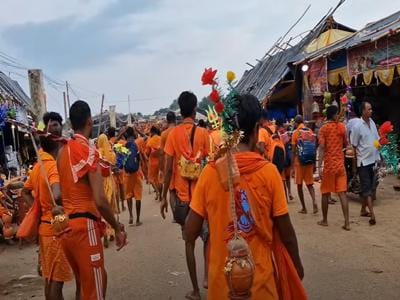WHAT IS KANWAR YATRA

What is Kanwar Yatra? Meaning, History, Rituals, Route & Significance
Kanwar Yatra is one of the biggest religious journeys in India, where lakhs of Lord Shiva’s devotees, called Kanwariyas, walk to bring holy Ganga water and offer it to Lord Shiva. This Yatra happens every year during the month of Shravan (Sawan), which usually falls in July–August.
If you’re wondering what is Kanwar Yatra, this post will explain everything in simple words – its meaning, how it started, what rituals people follow, and why it is so important in Hindu culture.
What is the Meaning of Kanwar Yatra?
The word ‘Kanwar’ means a bamboo pole with two pots tied on both sides. These pots are used to carry Ganga Jal (holy water). The word ‘Yatra’ means a religious journey. So, Kanwar Yatra means the journey where people bring Ganga water in a Kanwar and offer it to Lord Shiva.
The people who do this Yatra are called Kanwariyas. They wear orange/saffron clothes, walk barefoot, chant “Bol Bam” or “Har Har Mahadev”, and travel many kilometres with full devotion.
Story and History Behind Kanwar Yatra
There are many old stories from Hindu mythology related to Kanwar Yatra. One famous story is about the time of Samudra Manthan (churning of the ocean). A dangerous poison named Halahal came out. To save the world, Lord Shiva drank the poison, and to reduce its effect, the gods poured Ganga water on him.
Since then, it is believed that offering Ganga water to Lord Shiva in the month of Shravan helps in removing sins, fulfilling wishes, and getting Shiva’s blessings.
Another story is about Lord Parshuram, a great devotee of Shiva, who first brought Ganga water in a Kanwar and offered it to Shiva. This started the Kanwar Yatra tradition.
What Do Kanwariyas Do During Kanwar Yatra?
Kanwariyas follow strict discipline and spiritual rules during the Yatra:
- Fasting: Many Kanwariyas keep fast during the whole Shravan month or at least during their Yatra.
- Simple life: They avoid non-veg, alcohol, bad habits, and live like saints for that time.
- Walking barefoot: Most of them walk without slippers for many kilometres.
- No rest (Dak Kanwar): Some don’t even put the Kanwar down on the ground till they offer water to Shiva.
- Offering Water: The Ganga water is poured on Shiva Lingam, usually on a Monday, which is special for Shiva.
From Where to Where is Kanwar Yatra Done?
Kanwar Yatra starts from places where the Ganga river flows, and ends at Lord Shiva temples. Some popular routes are:
- Haridwar, Gaumukh, Gangotri (Uttarakhand): These are the most famous starting points.
- Sultanganj (Bihar) to Deoghar (Jharkhand): This is a 105 km long walk to Baidyanath Dham, one of the 12 Jyotirlingas.
- Varanasi, Allahabad, Garhmukteshwar (U.P.): Other known places for starting the Yatra.
- Destination Temples: The holy water is offered at temples like Kashi Vishwanath, Neelkanth Mahadev, Baidyanath Jyotirlinga, or even local Shiv temples.
During the journey, many people and organizations set up free food stalls, water camps, and resting tents for Kanwariyas.
Types of Kanwariyas
There are different kinds of Kanwariyas, based on how they do the Yatra:
- Dak Kanwariyas: They run and do not stop anywhere until they reach the temple.
- Baithi Kanwariyas: They walk slowly and take rest in between.
- Vehicle Kanwariyas: Some use bicycles, bikes, or trucks (though this is not considered as spiritual as walking).
Why is Kanwar Yatra Important?
Kanwar Yatra is very important for many reasons:
- Spiritual Benefit: Devotees believe that their sins are washed away by offering Ganga water to Lord Shiva.
- Blessings from Shiva: People pray for health, wealth, peace, marriage, and happiness.
- Shows Faith and Unity: Lakhs of people, from different places, come together and walk with devotion.
- Social Harmony: Many people volunteer during Yatra to serve food, water, and help others, showing community love and care.
Kanwar Yatra Today: A Big Event
Today, Kanwar Yatra has become one of the biggest religious gatherings in the world. In some years, more than 3 crore people join the Yatra.
The government and police make special arrangements during this time:
- Free shelters and Kanwar camps
- Medical teams and ambulances
- Clean water and toilets
- Traffic management and police security
The roads are sometimes closed for vehicles to give safe space to Kanwariyas.
Some Problems During the Yatra
Even though Kanwar Yatra is a spiritual journey, some challenges come with it:
- Traffic Jams: Due to large crowds, many highways are blocked or slow.
- Waste and Pollution: Many plastic bottles and garbage are thrown on the way.
- Safety Issues: Overcrowding or heat sometimes causes accidents or health problems.
Efforts are being made to make the Yatra cleaner and safer, like using reusable bottles, waste bins, and proper medical aid.
Final Thoughts
Now you know what is Kanwar Yatra – it’s not just a walk, it’s a deep act of love and devotion for Lord Shiva. Every step taken in this journey shows the faith, patience, and discipline of Kanwariyas.
Whether you are a Shiva devotee or just a curious traveller, the experience of seeing or joining the Kanwar Yatra will give you a sense of unity, simplicity, and strong belief in Indian spiritual culture.
If you ever plan to witness this amazing Yatra, do it with respect, care for others, and love for Lord Shiva.
